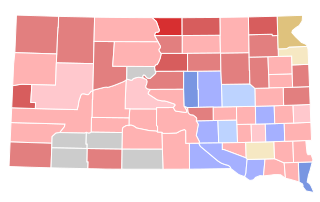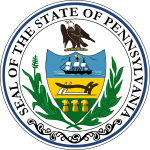
Robert Emory Pattison was an American attorney and politician who served as the 19th governor of Pennsylvania from 1883 to 1887 and 1891 to 1895. Pattison was the only Democratic Governor of Pennsylvania between the start of the American Civil War and the start of the Great Depression.

The 2006 Pennsylvania gubernatorial election was held on November 7, 2006, and included the races for the governor of Pennsylvania and lieutenant governor of Pennsylvania. Incumbent Democratic governor Ed Rendell successfully ran for re-election. Pennsylvania's first female lieutenant governor, Catherine Baker Knoll, was also running for re-election.

The 1904 New York state election was held on November 8, 1904, to elect the governor, the lieutenant governor, the Secretary of State, the state comptroller, the attorney general, the state treasurer, the state engineer, the chief judge and an associate judge of the New York Court of Appeals, as well as all members of the New York State Assembly and the New York State Senate.

The 1978 Pennsylvania gubernatorial election was held on November 7, 1978. Incumbent Governor Milton Shapp was constitutionally ineligible to run for a third consecutive term in office. Republican Dick Thornburgh defeated Democrat Pete Flaherty in the general election.

The 1835 Pennsylvania gubernatorial election was among three candidates. Incumbent Governor George Wolf ran as an Independent Democrat. In the end Joseph Ritner won the election and became Pennsylvania's only Anti-Masonic governor.

The 1922 United States Senate special election in Pennsylvania was held on November 7, 1922. Incumbent Republican Senator George Pepper, who had been appointed to the seat by Governor William Sproul following the death of Boies Penrose, was elected to fill the remaining four years on the term to which Penrose had been elected in 1920. Pepper comfortably defeated five other candidates, including Democratic nominee Fred Kerr of Clearfield County.

The 1906 Pennsylvania gubernatorial election occurred on November 6, 1906. Incumbent Republican governor Samuel W. Pennypacker was not a candidate for re-election.

The 1926 Pennsylvania gubernatorial election occurred on November 2, 1926. Incumbent Republican governor Gifford Pinchot was not a candidate for re-election. Republican candidate John Fisher defeated Democratic candidate Eugene C. Bonniwell to become Governor of Pennsylvania. Edward E. Beidleman, Thomas Wharton Phillips Jr., and John K. Tener unsuccessfully sought the Republican nomination.

The 1930 Pennsylvania gubernatorial election occurred on November 4, 1930. Incumbent Republican governor John Stuchell Fisher was not a candidate for re-election. Republican candidate and former governor Gifford Pinchot defeated Democratic candidate John M. Hemphill to win a second, non-consecutive term as Governor of Pennsylvania.

The 1934 Pennsylvania gubernatorial election occurred on November 6, 1934. Incumbent Republican governor Gifford Pinchot was not a candidate for re-election.

The 1938 Pennsylvania gubernatorial election occurred on November 8, 1938. Incumbent Democratic governor George Howard Earle III was not a candidate for re-election. Republican candidate Arthur James defeated Democratic candidate Charles Alvin Jones to become Governor of Pennsylvania. Gifford Pinchot unsuccessfully sought the Republican nomination, while Thomas Kennedy unsuccessfully sought the Democratic nomination.

The 1866 Pennsylvania gubernatorial election occurred on October 9, 1866. Incumbent governor Andrew Gregg Curtin, a Republican, was not running for re-election.

The 1869 Pennsylvania gubernatorial election occurred on October 12, 1869. Incumbent governor John W. Geary, a Republican, was a candidate for re-election. Geary defeated Democratic candidate Asa Packer to win another term.

The 1872 Pennsylvania gubernatorial election occurred on October 8, 1872. Incumbent governor John W. Geary, a Republican, was not a candidate for re-election.

The 1890 Pennsylvania gubernatorial election occurred on November 4, 1890. Democratic candidate and former Governor Robert E. Pattison defeated Republican candidate George W. Delamater to become Governor of Pennsylvania.

The 1902 Vermont gubernatorial election took place on September 2, 1902. Incumbent Republican William W. Stickney, per the "Mountain Rule", did not run for re-election to a second term as Governor of Vermont. Republican candidate John G. McCullough defeated Local Option candidate Percival W. Clement and Democratic candidate Felix W. McGettrick to succeed him. Since no candidate won a majority of the popular vote, the election was decided by the Vermont General Assembly in accordance with the state constitution, where McCullough was elected with 164 votes to 59 for Clement and 45 for McGettrick.

The 1902 Massachusetts gubernatorial election was held on November 4, 1902. Incumbent Republican Governor W. Murray Crane did not run for re-election. Lt. Governor John L. Bates was elected to succeed him, defeating Democratic nominee William A. Gaston and Socialist John C. Chase.

A general election was held in the U.S. state of Wyoming on Tuesday, November 4, 1902. All of the state's executive officers—the Governor, Secretary of State, Auditor, Treasurer, and Superintendent of Public Instruction—were up for election. Republicans held onto all statewide offices by landslide margins.

The 1922 South Dakota gubernatorial election was held on November 7, 1922. Incumbent Republican Governor William H. McMaster ran for re-election to a second term. After beating back a challenge in the Republican primary from perennial candidate George W. Egan, McMaster advanced to the general election, where he faced former State Senate President Louis N. Crill, the Democratic nominee, and suffragist Alice Lorraine Daly, the Nonpartisan League's nominee, and the first woman to run for governor. McMaster won by a large margin, but the race was considerably narrower than the 1920 election.

The 1902 Wisconsin gubernatorial election was held on November 4, 1902.























